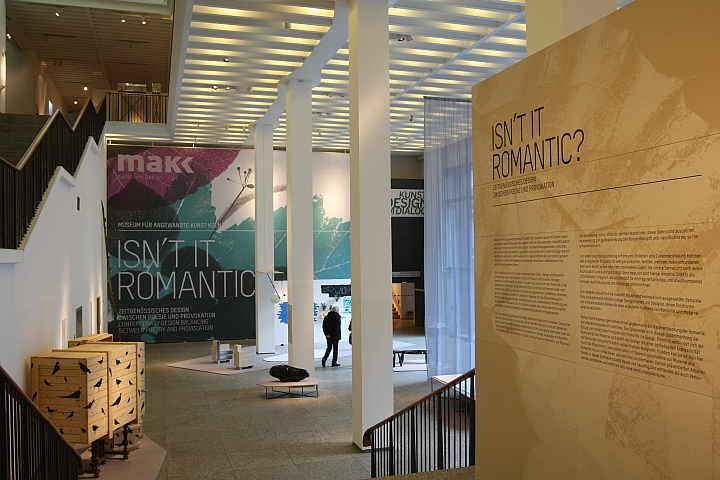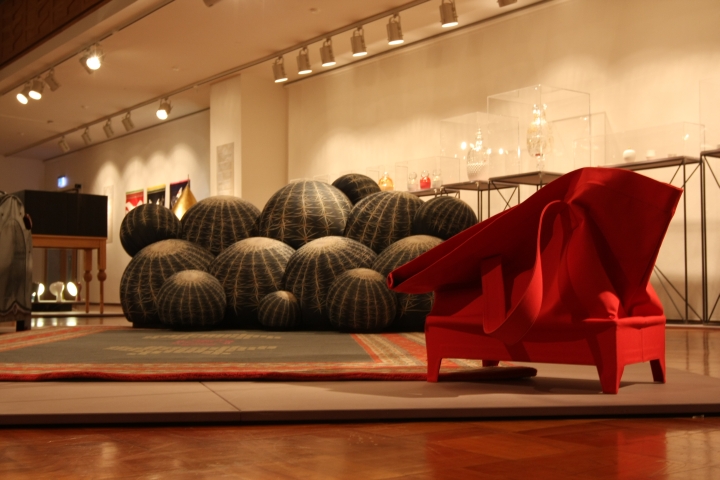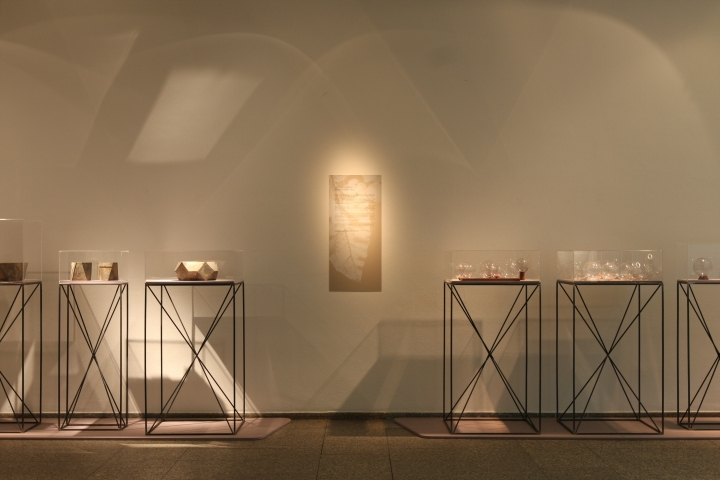The Museum für Angewandte Kunst Köln (MAKK) opened in 1888, and so it is somehow fitting that it should start the celebrations of its 125th anniversary with an exhibition exploring Romanticism in contemporary design.
Not just because a museal discussion of Romanticism refers neatly back to the prevailing atmosphere when the museum was being established; but because it also opens a window on our contemporary society and so potentially provides some pointers as to where the next 125 years will take us.

Featuring the works of some forty international design studios and curated by Vienna Design Week Director Tulga Beyerle, "Isn’t it romantic? Contemporary Design balancing between Poetry and Provocation" is split into two distinct parts.
The first looks at contemporary Romanticism in context of products which are available on the general market. The second looking at more experimental, conceptual works. A division which of course neatly reflects the current design world; split as it is between products for production and projects for galleries.
For us the weaker of the two sections is that looking at commercial products.
For us here is too much focus on Romanticism as kitsch; or put another way, for us it concentrates to heavily on understanding the romantic period from today's viewpoint rather than in terms of what Romanticism meant to those who lived and experienced it.
The industrial revolution brought not only upheaval and suffering to the people of Europe, but also wealth and freedom.
While some were forced to give up their poor but free peasant life for the servitude of the mill; the winners found themselves with cash. Great dirty plies of cash. And nothing to do all day.
Romanticism was part of their therapy.
They started writing poems or paid others to write poems for them, went off to look at the Alps or the Scottish Highlands, died of brain fever, broken hearts and other improbable illnesses and generally tried to find escape from the troublesome modern world through constructed realities.
The cultural goods that arose in the period were the protagonist's response to the prevailing climate.
And so much as we'd all like to believe he was, Caspar David Friedrich was never being ironic. He meant it.
What we now see as kitsch was created honestly and earnestly, much of what is on display in the MAKK is created to be intentionally kitsch. Ironically kitsch. Which then can't be argued to be a contemporary interpretation of Romanticism. Rather an individual interpretation of "romantic kitsch"
Is this making sense?
There are however a few excellent pieces on display, objects that for us do encapsulate the essence of the romantic age. Patricia Urquiola's Re-Trouvé chairs and table, for example, whisper to you that they are a place of childhood safety, especially through the clever juxtaposition with Bertjam Pot's Led Zeppelin lamp - an object which promises to shield you from the troubles of life. And even though we can't stop thinking of Louis by Anne Lorenz for maigrau as a student project, it is just the most delightful study into trying to find comfort and belonging in banal, soulless, household objects.
(And obviously we're not the only ones who can't stop thinking of it as a student project. In the official catalogue it is listed as it once was: "Home Traveller" and part of the kkaarrlls collection. We're sure there is a logical explanation....)
But for us, as we say, there is just a touch too much Romantacism à la Liberace.
We know that's part of the exhibition concept, but for us it just doesn't work as well as it could or indeed should.

The current situation in post-industrial Europe is of course not that much different to the one experienced in the mid 19th century.
Digitalisation, the decline of production and the rise of service industries has produced winners and losers. Then there are the challenges posed by our increasing awareness of our personal involvement in and responsibility for the pressing environmental and social issues of our time.
A lot of people are consequently insecure, out of their depth, don't know what to do and are on the search for a safe haven. A constructed reality.
Last year in the context of his book "21 Designers for 21st Century Britain", we asked Royal College of Art Senior Tutor Gareth Williams how he saw the future for designers, his answer "...many designers are very aware of the social and cultural context of what they do and I think designers have an important role to play in redefining how we live in the 21st century."
Examples of the sort of projects Gareth had in mind can be found in the excellent second section of the exhibition; which in contrast to the commercial products section presents a near literal expression of how we would define the interpretation of the romantic spirit into contemporary design. Objects that in essence no one needs or wants but which speak to us all in a way that feels private, comforting, supportive.
In Situ by Julien Carretero, for example, was conceived as part of the 2010 Dutch Invertuals exhibition "Matter of Time" and challenges us to either escape or stay and face reality. Pieke Bergman's Light Blubs scream "Told you so!" and reinforce our insecurity. Which in itself gives security. A more primal form of security meanwhile is, literally, given off by Hana Kurková's "Fine Brushes". When we saw them in Vienna we wrote "The bristles are pine needles. The brush smells like Christmas. Genius." Words we stand by. And so it is a real shame that they are being displayed behind glass in Cologne. They just look like brushes. You don't get the feeling of calm. Similarly the decision to place Frédéric Dedelly's Objects Mélancoliques behind glass robs them of all their heroism. Or maybe we're just remembering the strong impression they made during the 2012 Grassimesse in Leipzig.
But the shortfalls in the presentation can't detract in any way from what is a wonderful collection of wonderful projects.

Design obvioulsy didn't have a seat at the original romantic dining table.
Because it didn't exist back then.
And so it's wonderful that the MAKK and Tulga Beyerle are allowing it the opportunity to take a place alongside the other forms of cultural output that are already there.
The question if one can actually talk of a return to Romanticism in contemporary design, is however one that is left open for each visitor to answer for themselves.
We don't think you can. But you probably suspected we'd say that.
On the one hand our modern world is much more complex than that in the 19th century, cause and effect aren't as elegantly linked as once was the case.
And on the other, the objects on display arose independently, often over several years and for a number of reasons: not all of which had or have to do with the context in which they are now displayed.
Yes the objects can all be linked to Romanticism - "Seek and ye shall find" as it were - but for us they don't represent in any shape or form evidence of a new general movement amongst designers towards the spirit and motifs of Romanticism, and certainly can't justify some of the eye-watering hyperbole written in conjunction with the exhibition.
And indeed on the basis of some of the objects one could argue that Post-Modernism was a return to Romanticism. And if we're always returning to it, what's so new or interesting? While other objects imply that having learned the lessons of Modernism we are now actually returning to Arts and Crafts, redressing historical errors as it were. And if that's the case then Romanticism is just an historical reference.
Nor do we believe that any of the objects on display will serve as more than a footnote in design history. Far less signal new directions for either design or society. Which isn't to diss them. Far from it. Not everything can revolutionise.
Some of the ideas being developed in some of the projects on show will undoubtedly enter the mainstream, and we've certainly high hopes for one or the other. But they wont enter it in the context of contemporary Romanticism.
And ultimately, just as not all 19th century citizens stood around looking at mountain ranges in terrified awe before going home to read a 1000 page poem about knights good and bad or popping some arsenic in despair, so to are the majority of us today not really looking for escape or fulfilment.
A beer possibly. A hug definitely. But little more.
The minority who are looking to constructed realities to provide answers to their current woes are largely from the educated middle-class, invariably own something made of felt, and find articles in The Guardian about handmade Swedish butter "fascinating". And we all know who controls the cultural dialogue. And indeed who controlled it in the 19th century.
All that aside "Isn’t it romantic? Contemporary Design balancing between Poetry and Provocation" is to be highly recommended, not least because it allows us an insight into a fascinating new way of viewing those objects that surround us and of questioning why they surround us.
An excellently conceived and realised exhibition, "Isn’t it romantic?" makes wonderful use of the space available in that it doesn't overfill it with objects - a regular error in temporary museum exhibitions - but rather leaves space between the exhibits. Space for movement and thought. Which is very agreeable.
And Romantic.
In addition to the exhibition itself we can also thoroughly recommend the delightfully produced catalogue, featuring as it does intelligent articles from international experts including Design Museum London Director Deyan Sudjic, GRID Magazine's Gerrit Terstiege and of course exhibition curator Tulga Beyerle herself.
"Isn’t it romantic? Contemporary Design balancing between Poetry and Provocation" runs at the Museum für Angewandte Kunst Köln until April 21 2013. Full details can be found at www.makk.de